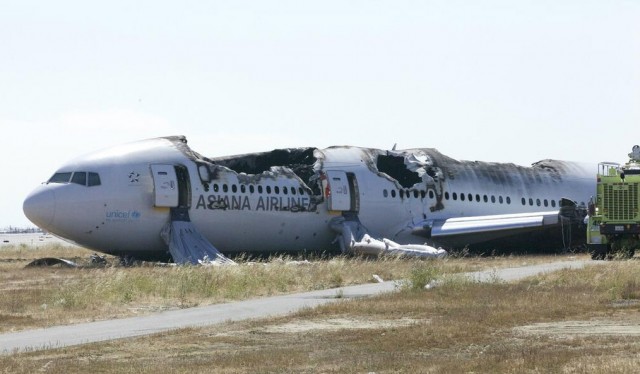
Exterior photograph of the Asiana Airlines Boeing 777 flight 214 crash from the NTSB.
The NTSB has just shared eight photos of the Asiana Airlines Boeing 777 flight 214 crash via Twitter and we wanted to share. Words cannot do these justice.
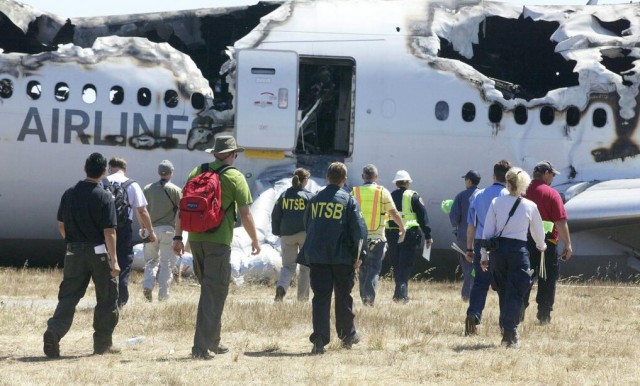
NTSB investigators head tothe the Asiana Airlines Boeing 777 crash. Photo via the NTSB.
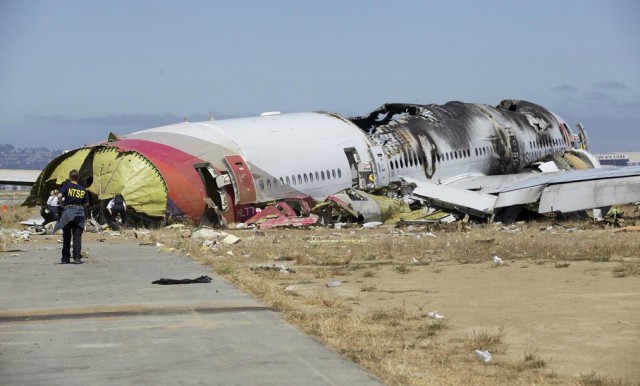
Photo of the Asiana Airlines Boeing 777 flight 214 crash from the NTSB.
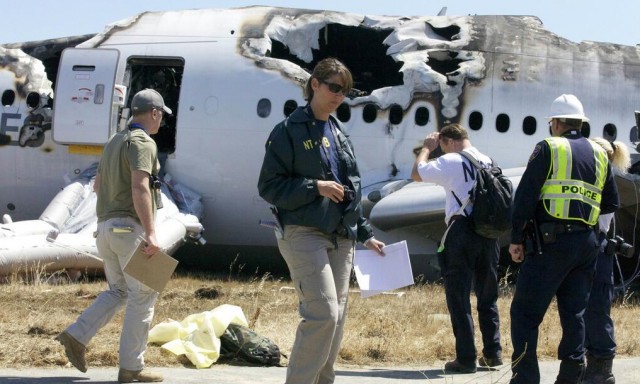
Photo of the Asiana Airlines Boeing 777 flight 214 crash from the NTSB.
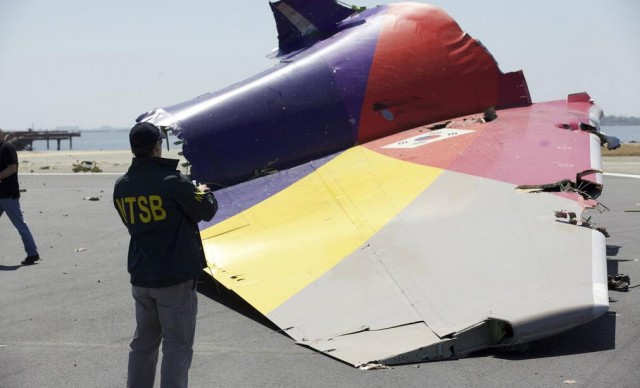
Tail section of the Asiana Airlines Boeing 777 flight 214 crash from the NTSB.
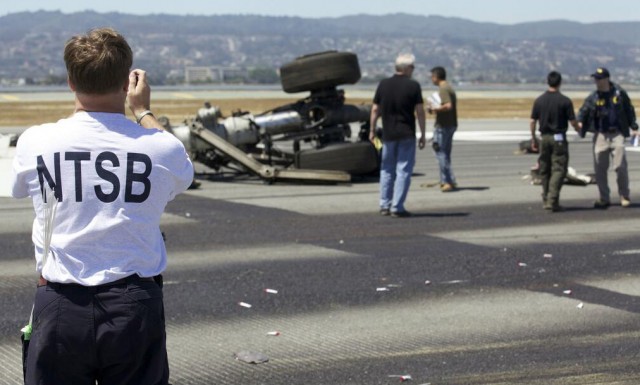
Photo of the Asiana Airlines Boeing 777 flight 214 crash from the NTSB.
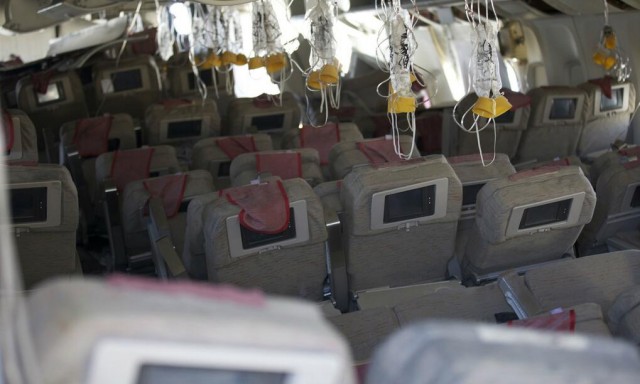
Cabin photo of the Asiana Airlines Boeing 777 flight 214 crash from the NTSB.
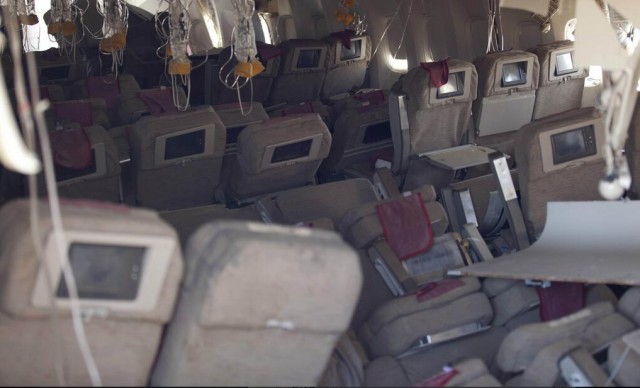
Interior photo of the Asiana Airlines Boeing 777 flight 214 crash from the NTSB.
It is incredible to think what it would have been like to be inside the aircraft at the time of crashing and the chaos that ensued. A big thanks to the NTSB for sharing these photos with the public.
 |
This story written by… David Parker Brown, Editor & Founder.
David started AirlineReporter.com in the summer of 2008, but has had a passion for aviation since he was a kid. Born and raised in the Seattle area (where he is currently based) has surely had an influence and he couldn’t imagine living anywhere else in the world.
@ARdpb | Flickr | YouTube | da***@*************er.com |
EDITOR-IN-CHIEF & FOUNDER - SEATTLE, WA. David has written, consulted, and presented on multiple topics relating to airlines and travel since 2008. He has been quoted and written for a number of news organizations, including BBC, CNN, NBC News, Bloomberg, and others. He is passionate about sharing the complexities, the benefits, and the fun stuff of the airline business. Email me: david@airlinereporter.com
https://www.airlinereporter.com
UPDATE 10: Photos & Details on Asiana Airlines Flight 214 Crash in San Francisco
A Few Thoughts on Asiana Airlines Flight 214 Crash at SFO









I think the real unsung heroes here (or maybe they are sung, and I just haven’t heard about it) are the flight attendants. Imagine coming to the end of a 12-hour shift, and being tired and jetlagged, and then being alert and acute enough to escort nearly 300 passengers to safety out of a burning airplane.
I know it’s what they’re trained for, but it’s still amazing. Bravo.
I agree, they did an amazing job. Kudos to all of the FA’s on this flight.
Thank you, Taylor. They receive intensive training in the hopes that this will never happen. Have you seen the WSJ posting about the tiny flight attendant who carried passengers out of the airplane — on her back???
I second Taylor’s comments! Congrats to the many men and women who helped escort the passengers off the plane.
There is no such thing as pilot error.
Design error; Management error; ATC error; HR error; Maintenance error – YES
Pilot erroe – NO.
Sorry, but I was married to a pilot and there is such a thing as pilot error. Not saying that this happened in this case but it does happen!
I really hope you’re being sarcastic.
This guy has no idea what he’s talking about. Don’t feed the troll.
Mr Cook , you have no understanding of flying an aircraft if you believe that !
The last Korean commercial airline fatality was out of Stansted to Milan, all the crew of the cargo 747 died. The first officer watched as the Captain flew the aircraft into the ground. Pilot error? Not in my opinion. “The commanding pilot maintained a left roll control input, rolling the aircraft to approximately 90 of left bank and there was no control input to correct the pitch attitude throughout the turn. The first officer either did not monitor the aircraft attitude during the climbing turn or, having done so, did not alert the commander to the extreme unsafe attitude that developed, and the maintenance activity at London/Stansted was misdirected. Investigators subsequently suggested, among other things, that Korean Air alter training materials and safety education to meet the “unique” Korean culture.”
The tragedy was foreseeable and a direct result of poor training.
“AT” I had to look up the meaning of “Troll” I have fifty years working for the following airlines:-Northwest, Cathay Pacific, Air UK, KLMUK, AOM French Airlibnes. Personal invective rarely furthers any discussion.
I await the findings of the NTSB but will not accept pilot error as the cause of any major airline accident, a personal opinion which you are entitled to reject, but I suggest you think about rather than give us the benefit of your knee jerk reaction, further I do not hide by a non de plume.
Ronald, the NTSB has just confirmed through the FDR and the CVR and the admittance of the Asiana Flight Ops that the PIC on this trip had only 43 hours and was on his maiden training flight into SFO. What is that called then when the aircraft is traveling at too low a landing speed the the call to Abort happened 1.5 seconds before landing? You need to be open to Pilot error and all forms of error. It seems you are , just not pilot error. This was Plot error pure and simple. They were trying to fix something that they got themselves into and it was too late.
This is the ideal answer. Evnyeore should read this
Ronald, the NTSB has just confirmed through the FDR and the CVR and the admittance of the Asiana Flight Ops that the PIC on this trip had only 43 hours and was on his maiden training flight into SFO. What is that called then when the aircraft is traveling at too low a landing speed the the call to Abort happened 1.5 seconds before landing? You need to be open to Pilot error and all forms of error. It seems you are , just not pilot error. This was Plot error pure and simple. They were trying to fix something that they got themselves into and it was too late.
Mr Cook , have you seen the news today and the video of the planes attitude ? I’m a Pilot as well and no one short of the Pilot Union President would argue this was not pilot error . There is no point of you arguing this as there is no argument . Pilots make errors and no amount of discussion can change that .
Hmm…in your opinion…I see.
Pure Pilot error ..
Pilot in Command had 43 hrs in type aircraft , now you think its not Pilot error .
Looking at some of the overhead photos of the site, has anyone found where the left/port engine went? Obviously the right/starboard engine is resting next to the aircraft.
Me too, wondering where it went!
what is also amazing is the the FA’s on this flight were handed this emergency with no prior warning, were dealing with people in a panic situation who spoke several different languages and flight attendants who themselves were injured. They are without doubt the real hero’s here. Getting everyone out as they did, amazing.
The flight attendants represent the very best of the airline industry. Their training is such that “they” hope they’ll never, ever have to employ it, but when necessary they are ready to save every soul on board. Often ignored, their safety briefings inform every passenger of vital information needed to survive a crash. It is, because most ignore these briefings, that their job is SO important. Left to their own devices, I can only assume that pure bedlam would ensue without their guidance.. So yes, there will be time enough to place blame. Pilot error, mechanical error.atmospheric conditions. There are important issues to be discovered and that will aid in future safety training at all airlines, but it is the flight attendants who “again” won and win the day. I humbly tip my hat and my gratitude to all who ensure this noble profession.
The Asiana Flight 214 – a Boeing 777-200 – crashed in favorable weather partly cloudy skies and light wind.The twin-engine Boeing 777-200 is one of the most popular and safest long-range planes, often used for flights of 12 hours or more, from one continent to another.
The Asiana Flight 214 originated from Shanghai, China, left Seoul”s Incheon International Airport 10 hours and 23 minutes before its crash landing on Runway 28 at SFO. The 7 yrs old old Pratt & Whitney PW4090 powered Boeing 777-200 entered final approach at an abnormally low speed of 98 knots per hour (181 km/h) – well below the target landing speed of 137 knots per hour (253 km/h).
The two pilots on Flight 214 were Lee Jung Min, 49, a graduate of the Korea Aerospace University who joined Asiana in 1996, and Lee Kang Kuk, 46, who started his career at the airline in 1994 and got his pilot”s license in 2001. Lee Jung Min has flown a total of 12,387 hours with 3,220 hours on a Boeing 777, while Lee Kang Kuk has flown a total of 9,793 hours, with only 43 hours of which were on a Boeing 777. The pilot – Lee Kang Kuk – did not make a distress call before landing. He came in short of the runway, tried to correct buy pulling up, got the nose too high and hit tail first. Pilot Lee Kang Kuk was attempting his first Boeing 777 landing at SFO, but his ninth overall with the Boeing 777. The aircraft crashed hard to the ground, smashed the landing gear and spun around. The fuel tanks ruptured, but being at the end of the flight did not contain a lot of fuel and the resulting fire was ”relatively” small and most of the passengers were able to get out in good shape.
The SFO Airport had intentionally disabled ground-based landing guidance system at the time of the crash. The Boeing 777-200, registered as HL7742, was delivered on March 07, 2006, and had accumulated 35,700 hrs on 5,185 cycles as of March 31, 2013.
Passengers Ye Mengyuan and Wang Linjia, both 16 years old from Jiangshan in eastern China may have been run over and killed by a rescue vehicle. One child and five adults remained in critical condition. A total of 307 people were on board, 291 passengers and 16 crew members. The passengers included 77 Koreans, 141 Chinese, 64 Americans, 3 Indians, 3 Canadians, 1 French, 1 Japanese and 1 Vietnamese.
On January 23, 2013, the Jet Airliner Crash Data Evaluation Centre (JACDEC) announced that Korean Airlines had the fifth worst safety record among 60 international airlines that were reviewed.
On January 06, 2007 – Korean Air Lines Flight 769 from Seoul to Akita, Japan, landed on an unoccupied taxiway instead of the intended runway 10, which was the airport’s only runway. The Boeing 737-900 aircraft with 124 passengers and 9 crew landed without any injury or damage.
On April 15, 1999 Korean Air Cargo Flight 6316 (McDonnell Douglas MD-11) from Shanghai to Seoul took off despite the Korean co-pilot”s repeated misunderstanding and miscommunication with the tower and the pilot. The aircraft climbed to 1,500 meters and the captain, after receiving two wrong affirmative answers from the first officer that the required altitude should be 500 meters, thought that the aircraft was 1,000 meters too high. The captain then pushed the control column abruptly forward causing the aircraft to start a rapid descent. Neither was able to recover from the dive. The airplane plummeted into an industrial development zone 10 kilometers southwest of Shanghai Hongqiao International Airport. The plane plunged to the ground, hitting housing for migrant workers, and exploded.
On March 15, 1999 — Korean Air Flight 1533 (McDonnell Douglas MD-83) from Seoul to Pohang departed for Pohang. Weather at Pohang was poor with degraded visibility and gusty 25 knot winds. The pilot failed at the first attempt to land. After the second approach the plane touched down, but overran the runway. The aircraft skidded through 10 antennas, a reinforced barbed wire fence and came to rest against an embankment. The landing snapped the fuselage in half.
On August 05, 1998 — Korean Air Flight 8702 (Boeing 747-400) from Tokyo to Seoul. The flight departed Tokyo at 16:50 for a flight to Seoul, scheduled to arrive there at 19:20. Inclement weather at Seoul forced the flight crew to divert to Jeju. The aircraft took off from Cheju at 21:07 bound for Seoul. On landing in Seoul, the 747 bounced multiple times and slid 100 meters off the runway before coming to a stop in a grassy area.
On August 06 1997 — Korean Air Flight 801 (Boeing 747-3B5) from Seoul to Agana, Guam, The crew attempted a night-time approach to Guam runway 06L. Flight 801 had descended 250 meters below the prescribed altitude, struck the 225 meters Nimitz Hill at a height of 200 meters and crashed in a jungle valley, breaking up and bursting into flames. Subsequent investigation found that the captain’s failure to adequately brief and execute the non-precision approach and the first officer’s and flight engineer’s failure to effectively monitor and cross-check the captain’s execution of the approach were directly responsible for the crash. It was the first fatal crash of the Boeing 747-300. Contributing factors were the captain’s fatigue and Korean Air’s inadequate flight crew training.
On September 22 1994 — Korean Air Flight 916F (Boeing 747) from Zurich to Busan. Eight days prior, the aircraft had encountered a severe hailstorm over Elba, Italy which led to a near miss incident. The aircraft sustained severe damage to the radome, cockpit windows and engines but managed to reach Zurich safely. Some repair work was done, but the aircraft needed to be ferried to Busan for final repairs. Boeing released the aircraft with some take-off performance changes, which included a limited gross weight by 70,000 pounds and increased takeoff speeds for V1, V2 and VR by 15, 17 and 14 knots respectively. The aircraft was cleared for a Runway 14 takeoff and ZUE 5P departure. After a long take-off run, the aircraft lifted off the runway at the very end and climbed slowly. At 900 meters beyond the runway end the aircraft cleared some adjacent buildings at fewer than 50 meters. Subsequent investigation found that despite clear instructions to reduce weight, the crew had overloaded the aircraft by 86,700 pounds
On August 10 1994 — Korean Air Flight 2033 (Airbus A300) from Seoul to Jeju, the flight approached faster than usual to avoid potential wind-shear. 15 meters above the runway the co-pilot, who was not flying the aircraft, decided that there was insufficient runway left to land and tried to perform a go-around against the captain’s wishes. The aircraft touched down 1,773 meters beyond the runway threshold. The aircraft could not be stopped on the remaining 1,227 meters of runway and overran at a speed of 104 knots. After striking the airport wall and a guard post at 30 knots, the aircraft burst into flames and was incinerated. The cabin crew was credited with safely evacuating all passengers although only half of the aircraft’s emergency exits were usable
On June 13 1991 — Korean Air (Boeing 727) from Jeju to Daegu, the aircraft performed an unexpected gear-up landing at Daegu. The crew failed to read out the landing procedure checklist and therefore didn’t select the gear down option. Subsequent investigation revealed that the pilot instructed the co-pilot to pull the fuse from the warning system because the repeated warnings that the landing gear was not deployed were, “irritating and distracting,” him as he attempted to land. With the warning horn disabled, the Korean pilot brought the plane in and slid down the length of the runway on the central structural rib in the belly of the aircraft
On July 27 1989 — Korean Air Flight 803 (McDonnell Douglas DC-10-30) from Jeddah to Tripoli. The aircraft initially departed Seoul on a flight to Tripoli with intermediate stops at Bangkok and Jeddah. Visibility was varying between 100—800 feet and the runway 27 ILS had been reported unserviceable. On final approach to runway 27 the aircraft crashed short of the runway, striking 4 houses and a number of cars.
December 23, 1983 – Korean Air Cargo Flight 084 (McDonnell Douglas DC-10) from Anchorage to Los Angeles, while taxiing out in fog, the Korean crew became disoriented and ended up on the wrong runway. During the takeoff run, the aircraft collided head-on with Southcentral Air Flight 59, a Piper Pa-31 which was taking off from runway 6L-24R for a flight to Kenai. The nine occupants of the South Central Air flight were injured. The DC-10 overran the runway by 1,434 feet and came to rest 40 feet right of the extended centerline. Federal Investigators determined that the Korean pilot had failed to follow accepted procedures during taxi – causing disorientation while selecting the runway. The pilot also failed to use the compass to confirm his position. Ultimately the pilot”s decision to proceed with takeoff without ever knowing if he was on the correct runway caused the impact.
On September 01, 1983 – Korean Air Flight 007 (Boeing 747-230B) departed from New York City for Seoul via Anchorage. At 5:00 AM the flight was cleared directly to the Bethel VOR beacon and then on to the Romeo 20 route. The pilot mistakenly diverted from its intended course and passed 12 miles north of the Bethel beacon. While approaching the Kamchatka peninsula, six Soviet MiG-23 fighters were scrambled. Because a U.S. Air Force Boeing RC-135 intelligence plane was flying in the area east off Kamchatka, the Soviets may have assumed the 747 radar echo to be the RC-135. The flight left Soviet airspace over the Sea of Okhotsk and the fighters returned to their base. Passing abeam the Nippi beacon (four hours after take-off), the aircraft was 185 miles off course and headed for Sakhalin. Two Soviet Su-15 ‘Flagon’ fighters were scrambled from the Dolinsk-Sokol airbase. At 18:16 UTC, flight 007 re-entered Soviet airspace. At 18:22, for the second time, Soviet command ordered destruction of the target. Two air-to-air missiles were launched by one of the fighters and one struck the Boeing at 18:26. Cabin pressure was lost and the aircraft suffered control problems, causing the plane, after a 12 minute flight, to spiral into the sea near Moneron Island. The event was denounced by the US Reagan Administration as a deliberate and wanton act of murder by an “evil empire.
On April 20, 1978 — Korean Air Flight 902 (Boeing 707) departed from Paris for Anchorage and flew to within 780 km of the North Pole when Canadian officials alerted the crew they were off course. They changed course, but worsened the situation by setting a course directly across the Barents Sea and Soviet airspace. The plane was initially recognized by Soviet anti-aircraft defense radars as a Boeing 747. Sukhoi Su-15TM jets were sent to intercept. When both jets were flying next to the Korean airliner, the Korean captain claimed he slowed the plane and initiated landing lights. Nevertheless the Su-15 crews were ordered to shoot down the plane. According to US intelligence sources the Soviet pilot tried for several minutes to convince his superiors to cancel the attack on the civilian airliner. After an additional order two P-60 rockets were launched. The first missed but the second severely damaged the left wing and shrapnel punctured the fuselage, causing rapid decompression that killed two passengers. The Korean pilot initiated an emergency descent to 5,000 feet and entered clouds. Both Soviet jets lost the Korean plane in the clouds. The aircraft continued at low altitude, crossing the Kola Peninsula while searching for a landing opportunity. With night quickly coming on, several unsuccessful attempts were made before the plane landed on the ice of Lake Korpijà¤rvi, near Kem, USSR. All occupants were rescued by Soviet helicopters. Damage— severe, Injuries— multiple, Deaths- 2 (two of 197 passengers)
On August 02 1976 — Korean Air (Boeing 707) cargo flight departed from Tehran for Seoul when, on takeoff from runway 29, the aircraft inexplicably deviated from the Standard Instrument Departure (SID) procedure and drifted to the right instead of performing a left turnout. It continued and struck mountains at an altitude of 2,020 meters
@Thayabharan
You are quoting Korean Air accidents. They are as different from Asiana as American Airlines is from United Airlines or Air India is from Kingfisher!
why is their a term ” pilot error” then if it doesnt exist ??:)!!!!
So sad
I think what you wrote made a great deal of sense.
However, consider this, suppose you were to write a awesome headline?
I ain’t saying your information isn’t solid,
however suppose you added something that grabbed folk’s attention? I mean AirlineReporter.com « The NTSB Releases 8 Amazing Photos of the Asiana Airline’s Crash is a
little boring. You ought to look at Yahoo’s home page and see how they
create article headlines to get people interested. You might
add a video or a pic or two to grab readers excited about everything’ve got to say.
In my opinion, it could bring your blog a little livelier.
yep
I think what you wrote made a great deal of sense.
However, consider this, suppose you were to write a awesome headline?
I ain”t saying your information isn”t solid,
however suppose you added something that grabbed folk”s attention? I mean AirlineReporter.com � The NTSB Releases 8 Amazing Photos of the Asiana Airline�s Crash is a
little boring. You ought to look at Yahoo”s home page and see how they
create article headlines to get people interested. You might
add a video or a pic or two to grab readers excited about everything”ve got to say.
In my opinion, it could bring your blog a little livelier.
yep
ummm